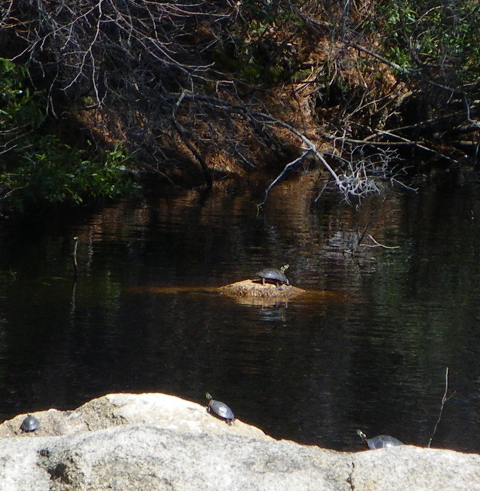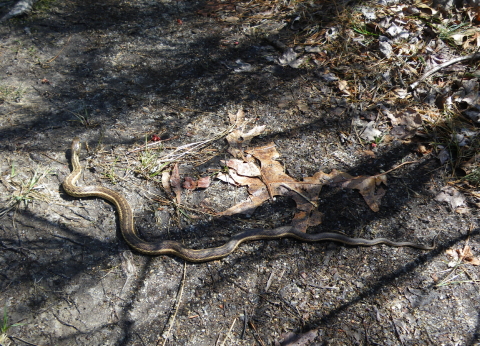Common Garter Snake in Goldwitz Bog
The Turtle Journal team visited nearby bog wetlands this morning in hopes of finding their first snake of the season. Last night howled with storms that pelted the South Coast with torrential downpours, yet temperatures remained mild in the mid-50s. The early morning high tide, augmented by a fierce southwesterly gale, flooded banks of Sippican Harbor in Buzzards Bay. As the sun rose, though, the day moderated and glistened in bright sunshine. Perhaps today would mark our first springtime encounter with the slithering reptiles.
Painted Turtles Basking in Bog Reservoir
We waltzed along bog channels to check for basking spotted turtles. Alas, none were to be found. At the reservoir, though, painted turtles staked out basking rocks as they increased their internal body temperatures to begin foraging and then mating.Â
Common Garter Snake Basking at Goldwitz Bog
Even though Don had been expecting to find the first snake of the season basking along the bog path today, he managed to step right over this good sized garter snake that had completely blended into the pathway as if it were a protruding tree root. Luckily, Sue spotted the snake that Don had nearly tripped over.
Common Garter Snake (Thamnophis sirtalis)
Common garter snakes are widely distributed throughout North America. Since garter snakes are the Massachusetts’ state reptile, it seemed fitting to be the first snake that we encountered this spring season.
Northern Water Snake (Nerodia sipedon)
Garter snakes are not the only snakes found in the wetlands of the abandoned Goldwitz cranberry bog. One of the first slithering reptiles we discovered in this locale was the northern water snake, a large, “non-venomous” snake native to North America. They are darkly colored and interestingly patterned and are sometimes mistaken for copperheads. These snakes aggressively defend themselves by repeatedly striking and biting when cornered, and their saliva contains a mild anti-coagulant. Since Don is on a strong anti-coagulant, he has no desire to test the limits of this “non-venomous” additive.
Juvenile Northern Water Snake (Nerodia sipedon)
The Turtle Journal team ran into a juvenile northern water snake at the bog a while back that proved everything that books say about their aggressive behavior. We have never seen a more combative critter in our field studies.
Aggressive Juvenile Northern Water Snake
Don gently prodded the vicinity of this juvenile snake to assess it reaction. And, boy, did it react! After the first few strikes at the pole end of our ten foot long net, we were really glad that the pole was ten feet long. Despite that energetic encounter, snakes remain one of our favorite Turtle Journal creatures. They are extremely beneficial to the environment and the eco-system, and they’re just plain gorgeous … once you get beyond the slithering cold-blooded reptile thing (smile).




